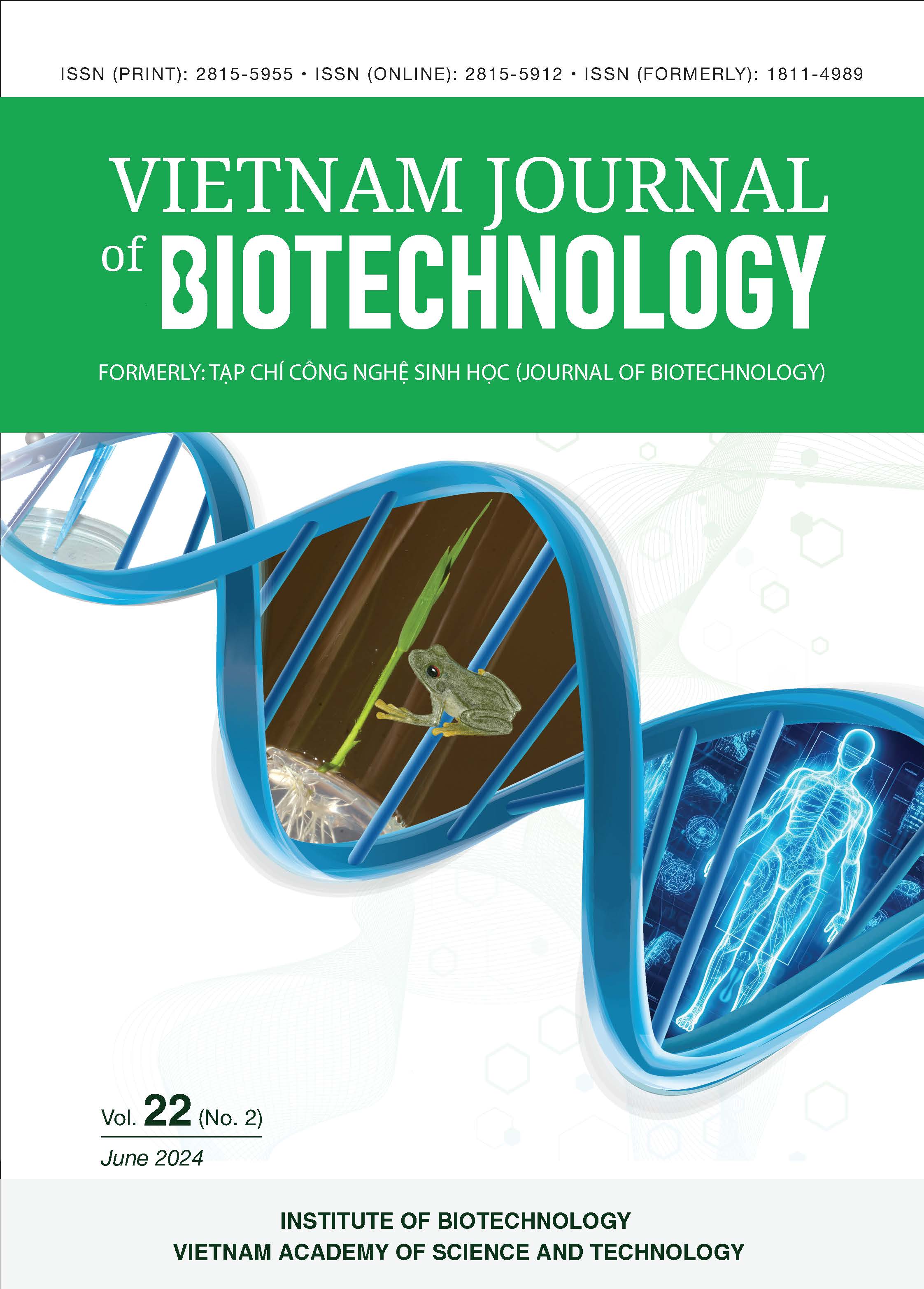Codon optimization, expression, and purification of the reverse transcriptase enzyme variant MMLV RT2 in Escherichia coli
Author affiliations
DOI:
https://doi.org/10.15625/vjbt-19874Keywords:
affinity chromatography, codon optimization, expression, Moloney leukemia, reverse transcriptaseAbstract
Moloney leukemia virus reverse transcriptase (MMLV RT) is an important enzyme widely utilized in molecular biology research and various diagnostic testing kits. A previous study demonstrated that variants of MMLV RT containing specific mutations contribute to enhanced stability and increased capability for RNA detection. However, the optimization and increased expression level of MMLV RT variants for large-scale production have not been extensively studied. In this research, the gene segment encoding the MMLV RT variant (E286R/E302K/L435R/D524A) was codon optimized and subcloned into pET-M expression vector. The obtained pET-M MMLV RT2 was transformed into E. coli BL21(DE3) host cell system for over-expression of the MMLV RT2 enzyme. The recombinant enzyme was then purified using nickel affinity chromatography and quantified using the Bradford method. The results revealed significant increase in recombinant enzyme yield, achieving 0.25 g/L in the culture medium. This represents a 1.4-fold increase compared to the 0.175 g/L yield reported in the previous study. Enzyme MMLV RT2 was also evaluated for its activity and was found to have comparable activity to the commercial enzyme Promega and another variant, enzyme MMLV RT1, which carries the D524A mutation and has previously been evaluated for activity. This result suggests that a high expression level of a stable MMLV-RT enzyme variant can be achieved which is beneficial for further improving the production of this important enzyme. The high yield and sustained activity of the MMLV RT2 variant indicate its potential as a reliable and cost-effective alternative for various applications in research and diagnostics. The successful optimization and expression in E. coli highlight the feasibility of large-scale production, potentially lowering costs and improving accessibility for molecular biology applications.
Downloads
References
Arezi, B., & Hogrefe, H. 2009. Novel mutations in Moloney Murine Leukemia Virus reverse transcriptase increase thermostability through tighter binding to template-primer. Nucleic acids research, 37(2): 473-481. https://doi.org/10.1093/nar/gkn952.
Baranauskas, A., Paliksa, S., Alzbutas, G., Vaitkevicius, M., Lubiene, J., Letukiene, V., Burinskas, S., Sasnauskas, G., & Skirgaila, R. 2012. Generation and characterization of new highly thermostable and processive M-MuLV reverse transcriptase variants. Protein Engineering, Design & Selection, 25(10): 657-668. https://doi.org/10.1093/protein/gzs034.
Barber, R. D., Harmer, D. W., Coleman, R. A., & Clark, B. J. 2005. GAPDH as a housekeeping gene: analysis of GAPDH mRNA expression in a panel of 72 human tissues. Physiological genomics, 21(3): 389-395. http://doi.org/10.1152/physiolgenomics.00025.2005.
Coté, M. L., & Roth, M. J. 2008. Murine leukemia virus reverse transcriptase: structural comparison with HIV-1 reverse transcriptase. Virus research, 134(1-2): 186-202. https://doi.org/10.1016/j.virusres.2008.01.001.
Edelheit, O., Hanukoglu, A., & Hanukoglu, I. 2009. Simple and efficient site-directed mutagenesis using two single-primer reactions in parallel to generate mutants for protein structure-function studies. BMC biotechnology, 9: 1-8. https://doi.org/10.1186/1472-6750-9-6.
Frumkin, I., Lajoie, M. J., Gregg, C. J., Hornung, G., Church, G. M., & Pilpel, Y. 2018. Codon usage of highly expressed genes affects proteome-wide translation efficiency. Proceedings of the National Academy of Sciences, 115(21): E4940-E4949. https://doi.org/10.1073/pnas.1719375115.
Gerard, G. F., & D’Alessio, J. M. 1993. Reverse Transcriptase (EC 2.7. 7.49) The Use of Cloned Maloney Murine Leukemia Virus Reverse Transcriptase to Synthesize DNA from RNA. Enzymes of molecular biology: 73-93. https://doi.org/10.1007/BF02762340.
Katano, Y., Li, T., Baba, M., Nakamura, M., Ito, M., Kojima, K., Takita, T., & Yasukawa, K. 2017. Generation of thermostable Moloney murine leukemia virus reverse transcriptase variants using site saturation mutagenesis library and cell-free protein expression system. Bioscience, Biotechnology, and Biochemistry, 81(12): 2339-2345. https://doi.org/10.1080/09168451.2017.1394790.
Konishi, A., Hisayoshi, T., Yokokawa, K., Barrioluengo, V., Menéndez-Arias, L., & Yasukawa, K. 2014. Amino acid substitutions away from the RNase H catalytic site increase the thermal stability of Moloney murine leukemia virus reverse transcriptase through RNase H inactivation. Biochemical and biophysical research communications, 454(2): 269-274. https://doi.org/10.1016/j.bbrc.2014.10.044.
Mizuno, M., Yasukawa, K., & Inouye, K. 2010. Insight into the mechanism of the stabilization of Moloney murine leukaemia virus reverse transcriptase by eliminating RNase H activity. Bioscience, biotechnology, and biochemistry, 74(2): 440-442. https://doi.org/10.1271/bbb.90777.
Nguyen Van Sang, Nguyen Thi Thu Huyen, Ho Thi Yen, & Nguyen Thi Uyen. 2023. Expression, purification, and activity determination of M-MLV reverse transcriptase enzyme with RNase H domain mutations in E. coli host. Scientific Report at the National Biotechnology Conference 2023, (34): 216-222.
Rein, A. 2011. Murine leukemia viruses: objects and organisms. Advances in virology, 2011. https://doi.org/10.1155/2011/403419.
Schultz, S. J., & Champoux, J. J. 2008. RNase H activity: structure, specificity, and function in reverse transcription. Virus research, 134(1-2): 86-103. https://doi.org/10.1016/j.virusres.2007.12.007.
Wong, L., Pearson, H., Fletcher, A., Marquis, C. P., & Mahler, S. 1998. Comparison of the efficiency of moloney murine leukaemia virus (M-MuLV) reverse transcriptase, RNase H--M-MuLV reverse transcriptase and avian myeloblastoma leukaemia virus (AMV) reverse transcriptase for the amplification of human immunoglobulin genes. Biotechnology Techniques, 12: 485-489. https://doi.org/10.1023/A:1008871608947.
Yasukawa, K., Mizuno, M., Konishi, A., & Inouye, K. 2010. Increase in thermal stability of Moloney murine leukaemia virus reverse transcriptase by site-directed mutagenesis. Journal of biotechnology, 150(3): 299-306. https://doi.org/10.1016/j.jbiotec.2010.09.961.
Yu, C.-H., Dang, Y., Zhou, Z., Wu, C., Zhao, F., Sachs, M. S., & Liu, Y. 2015. Codon usage influences the local rate of translation elongation to regulate co-translational protein folding. Molecular cell, 59(5): 744-754. https://doi.org/10.1016/j.molcel.2015.07.018.
Downloads
Published
How to Cite
Issue
Section
Funding data
-
National Foundation for Science and Technology Development
Grant numbers 106-NN.02-2016.58.







